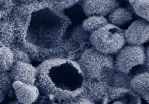(Press-News.org) OAKLAND, Calif., Nov. 21, 2014 -- Digoxin, a drug commonly used to treat heart conditions, was associated with a 71 percent higher risk of death and a 63 percent higher risk of hospitalization among adults with diagnosed atrial fibrillation and no evidence of heart failure, according to a Kaiser Permanente study that appears in the current online issue of Circulation: Arrhythmia and Electrophysiology.
Digoxin is a drug derived from digitalis, which has been used for more than a century for heart-rate control in patients with atrial fibrillation, and it remains commonly used for this purpose worldwide. Current clinical practice guidelines for the management of atrial fibrillation recommend the use of digoxin alone for resting heart-rate control in sedentary individuals.
"Our findings suggest that the use of digoxin should be re-evaluated for the treatment of atrial fibrillation in contemporary clinical practice," said study co-author Anthony Steimle, MD, Chief of Cardiology at Kaiser Permanente Santa Clara Medical Center. "Given the other options available for heart-rate control, digoxin should be used with caution in the management of atrial fibrillation, especially in the absence of symptomatic systolic heart failure."
The results of this study follow on the findings by many of the same investigators in a 2013 study that revealed digoxin was associated with a 72 percent higher rate of death among adults with newly diagnosed systolic heart failure.
The current study was conducted between Jan. 1, 2006 and June 30, 2009 among almost 15,000 adults within Kaiser Permanente's Northern and Southern California regions who had recently diagnosed atrial fibrillation and no prior heart failure or digoxin use. Researchers examined the independent association between newly initiated digoxin use and the risks of death and hospitalization.
During the study period, 4,858 or 17.8 percent of the participants initiated digoxin use. There were 1,140 deaths among the study cohort, with a significantly higher rate of death in digoxin users compared with non-users (8.3 vs. 4.9 per 100 person years). At the same time, there were 8,456 hospitalizations for any cause, and the rate of hospitalization was higher for patients who received digoxin compared with those who did not (60.1 vs. 37.2 per 100 person years).
"Digoxin remains commonly used for rate control in atrial fibrillation, but very limited data exist to support this practice -- mostly small, older clinical studies with very limited follow-up that did not assess the long-term effects of digoxin on mortality or hospitalization," said Alan S. Go, MD, senior author of the study and research scientist at the Kaiser Permanente Division of Research in Oakland, California.
"In contrast, this study included the largest and most diverse sample of adults with incident atrial fibrillation not complicated by heart failure treated in clinical practice reported to date, with results that were consistent across age and gender," said Dr. Go. "We believe these findings, which build on earlier work, have significant value in guiding clinical cardiology decision-making in regard to digoxin use in the modern era."
INFORMATION:
Other authors on the study include James V. Freeman, MD, MPH of Yale University School of Medicine; Kristi Reynolds, PhD, and Teresa N. Harrison, SM, of the Department of Research and Evaluation, Kaiser Permanente Southern California; Margaret Fang, MD, MPH, of the University of California, San Francisco; Natalia Udaltsova, PhD, and Niela K. Pomernacki, BA, of the Division of Research, Kaiser Permanente Northern California; Leila H. Borowsky, MPH, of Massachusetts General Hospital; and Daniel E. Singer, MD, of Harvard Medical School.
The study was supported by the National Heart, Lung and Blood Institute and the National Institutes of Health [RC2 HL101589 and U19 HL91179], and the American Heart Association Pharmaceutical Roundtable-Spina Cardiovascular Outcomes Research Center program [0875162N].
About the Kaiser Permanente Division of Research
The Kaiser Permanente Division of Research conducts, publishes and disseminates epidemiologic and health services research to improve the health and medical care of Kaiser Permanente members and the society at large. It seeks to understand the determinants of illness and well-being and to improve the quality and cost-effectiveness of health care. Currently, the Division's 550+ staff are working on more than 350 ongoing research studies in behavioral health and aging, cancer, cardiovascular and metabolic conditions, health care delivery and policy, infectious diseases, vaccine safety and effectiveness, and women's and children's health.
About Kaiser Permanente
Kaiser Permanente is committed to helping shape the future of health care. We are recognized as one of America's leading health care providers and not-for-profit health plans. Founded in 1945, our mission is to provide high-quality, affordable health care services and to improve the health of our members and the communities we serve. We currently serve approximately 9.5 million members in eight states and the District of Columbia. Care for members and patients is focused on their total health and guided by their personal physicians, specialists and team of caregivers. Our expert and caring medical teams are empowered and supported by industry-leading technology advances and tools for health promotion, disease prevention, state-of-the-art care delivery and world-class chronic disease management. Kaiser Permanente is dedicated to care innovations, clinical research, health education and the support of community health. For more information, go to: kp.org/share.
Patients who receive more cells get significant benefits. That's a key lesson emerging from a clinical trial that was reported this week at the American Heart Association meeting in Chicago.
In this study, doctors treated heart attack patients with their own bone marrow cells, selected for their healing potential and then reinjected into the heart, in an effort to improve the heart's recovery.
In the PreSERVE-AMI phase II trial, physicians from 60 sites treated 161 patients, making the study one of the largest to assess cell therapy for heart attacks in the United States. ...
Scientists have identified four new genes associated with the severe food allergy eosinophilic esophagitis (EoE). Because the genes appear to have roles in other allergic diseases and in inflammation, the findings may point toward potential new treatments for EoE.
"This research adds to the evidence that genetic factors play key roles in EoE, and broadens our knowledge of biological networks that may offer attractive targets for therapy," said study leader Hakon Hakonarson, M.D., Ph.D., director of the Center for Applied Genomics at The Children's Hospital of Philadelphia ...
Study says leopards stay surprisingly close to homes
Leopard home range around humans can be comparable to world's best protected areas
Article available from PLOS ONE
NEW YORK (November 21, 2014) - In the first-ever GPS-based study of leopards in India, led by WCS and partners has delved into the secret lives of these big cats, and recorded their strategies to thrive in human-dominated areas.
The study concludes that leopards in human areas are not always 'stray' or 'conflict' animals but residents, potentially requiring policy makers to rethink India's leopard-management ...
November 21, 2014 -- A study conducted by researchers at Columbia University's Mailman School of Public Health shows that obesity costs the U.S. $8.65 billion per year as a result of absenteeism in the workplace --more than 9% of all absenteeism costs. The consequences of obesity among the working population go beyond healthcare and create a financial challenge not only for the nation but for individual states as well. Findings are published online in the Journal of Occupational and Environmental Medicine.
The study is the first to provide state-level estimates of obesity-attributable ...
Lugano/Geneva, Switzerland, 21 November 2014 - New evidence that immune checkpoint inhibitors may work in glioblastoma and brain metastases was presented today by Dr Anna Sophie Berghoff at the ESMO Symposium on Immuno-Oncology 2014 in Geneva, Switzerland.
The novel research shows that brain metastases have dense concentrations of tumour infiltrating lymphocytes, providing an immunoactive environment. Moreover, both primary and secondary brain cancers often exhibit high expression of the immunosuppressive factor programmed cell death ligand 1 (PDL1), which can be inhibited ...
One of the most mysterious forms of life may turn out to be a rich and untapped source of antibacterial drugs.
The mysterious life form is Archaea, a family of single-celled organisms that thrive in environments like boiling hydrothermal pools and smoking deep sea vents which are too extreme for most other species to survive.
"It is the first discovery of a functional antibacterial gene in Archaea," said Seth Bordenstein, the associate professor of biological sciences at Vanderbilt University who directed the study, "You can't overstate the significance of the antibiotic ...
Prison policies vary on treating transgendered inmates, which could put inmates and institutions at risk. Gina Gibbs, a University of Cincinnati criminal justice doctoral student, will present a synopsis of the legal issues posed by such inmates at the annual meeting of the American Society of Criminology. The national conference runs from Nov. 19-22 in San Francisco.
At the center of the debate are Eighth Amendment protections against cruel and unusual punishment, widely varying policies on the treatment of transgendered populations and, Gibbs says, court crackdowns ...
CHAMPAIGN, Ill. -- Retired baseball stars Barry Bonds, Mark McGwire and Rafael Palmeiro each had Hall of Fame-worthy numbers, each hitting more than 500 home runs.
All three also were tarred by allegations of steroid use.
Their stories, however, received very different treatment over 12 years of national television news coverage, says University of Illinois professor Brian Quick, lead author on a paper about that coverage and its effects, published online Nov. 20 by the journal Communication Research.
"We found that Bonds received more than twice as many negative stories ...
This news release is available in German. One lesson that policymakers and financial regulators have drawn from the financial market crisis is that banks need to be backed by more equity. But banks have found it hard to increase their core capital positions - in other words, the equity available to them long-term. Since 2009, this has led European banks to increasingly deploy an instrument that allows them to convert debt into equity in times of need: contingent convertible bonds, also known as CoCo bonds. Banks issue these bonds at fixed interest rates - as is normal ...
Gases don't conduct heat as well as solids do. Cellular or aerated concretes take advantage of this effect, which experts call "gas-phase insulation". The heat barrier is achieved by air encased in the cavities of the concrete. But gas-phase insulation has far greater potential than keeping our homes warm. It can also be used to protect turbine engine and waste incinerator components when subjected to intense heat. All you need to do is transfer this effect to a coating that is just a few hundred micrometers thick.
Temperature differences of over 400 degrees Celsius
Scientists ...





